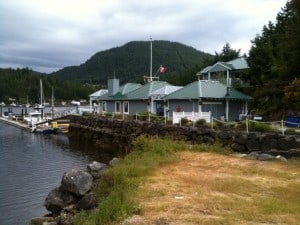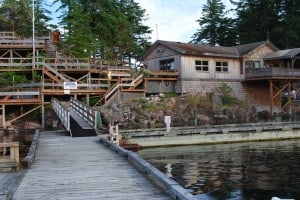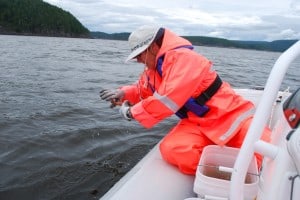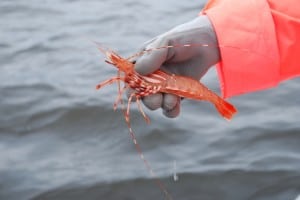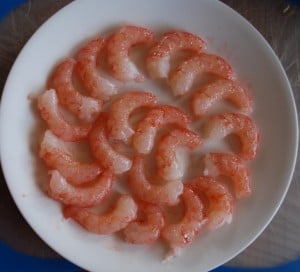It was really peaceful in Garden Bay, deep inside Pender Bay on the Sunshine Coast of British Columbia. For several days the weather forecasts had been for high winds out on the Strait of Georgia, and we were content to stay put.
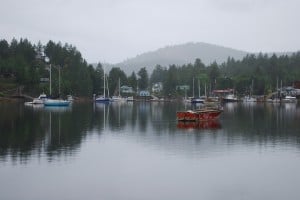
This is what several of our days at Garden Bay looked like – calm, overcast, often with a light misty rain falling. This shot is looking across Garden Bay from the outstation. The Royal Vancouver Yacht Club's outstation is the gray building to the left of center. The pub is the red building to the right of center.
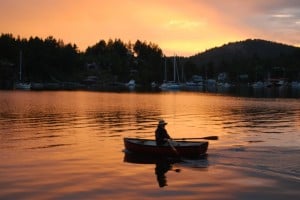
One evening after dinner we were watching the sunset get better and better. Suddenly, a lady at a nearby dock climbed into her small rowboat and passed behind us, very obviously on a mission. I instantly knew it would be a great photo as she passed by our stern, and as you can see, it’s pretty close to being a photo competition candidate. It was quiet enough that she could hear the fake shutter sound on my Nikon digital camera, and when she looked over I apologized for taking her photo without asking, but told her that I only had a moment to shoot and decided to take it first and ask later. She rowed over to talk with us and we had a good ten minute conversation. She lives just a short ways away on the water, and she rows over every night to see an elderly friend. Sure enough, every night we saw her come and go. (This photo isn’t Photoshop’d in any way – it’s exactly as I downloaded it from my camera.)
(Don’t forget, you can click on any image to see an enlargement of it. You can also view the blog post in a better format by logging online and reading it there.)
The last time we were here was in 2007 with Cosmo Place, our 42’ Nordic Tug, and it was our first-ever summer of cruising. When we departed Garden Bay and turned north in the Strait of Georgia to head for Desolation Sound, all hell broke loose, with huge waves and high winds that we’d never experienced before. After crashing through this for a half hour, with both dogs and the cat taking cover for their lives, we headed back to Garden Bay. On the way, we hit two logs in the water, not more than five minutes apart, both perpendicular to us and floating in the wave troughs – making them impossible to see. Back in Garden Bay we hired a diver to take a look at Cosmo Place’ hull and running gear to see if we had any damage to the hull, prop, or prop shaft – we didn’t but were extremely lucky. Two days later we made our second departure and had a good run in much nicer weather to Desolation Sound. We hoped this year wouldn’t be a repeat.
Earlier in the day (same day I took the sunset photo), I took Gator for a walk. It was intended to be just up the nearby road a ways to give his (and my) legs a bit of exercise. We ended up walking to the other side of Garden Bay to a tiny settlement that contains the Royal Vancouver Yacht Club Outstation, a couple of restaurants, a small marina, a very small general store, and a ramshackle hotel. It was a good two-hour walk, and I think I tired poor Gator out.
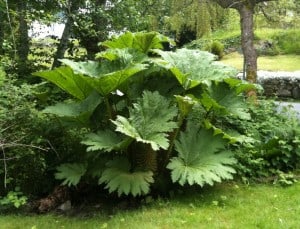
During our walk, I came across three different properties that had this very strange flowering plant growing in it. I’ve never seen such a plant before, with cone-shaped leaves that are at least 18-24” in diameter, and with foliage near the stalk that looks like fern.
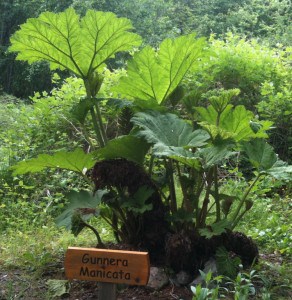
At the pub, I found one under a tree outside, and it had a sign in front of it (click on the photo to see the enlarged version). As you can see, the sign says “Gunnera Manicata”. When I Google’d that name, I found it’s a Brazilian plant of the giant rhubarb variety. That’s a new one!
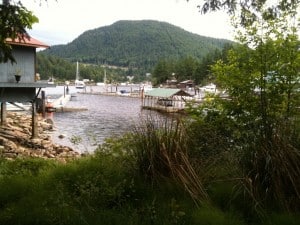
This photo looks back across Garden Bay to the Seattle Yacht Club Outstation – Flying Colours is in the very center of the photo, but there’s no way to make it out at this resolution.
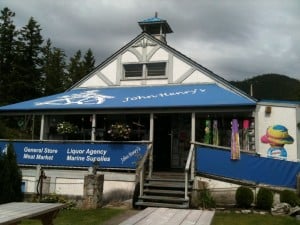
The John Henry general store in the tiny Garden Bay settlement. It had more bait and tackle than foodstuffs.
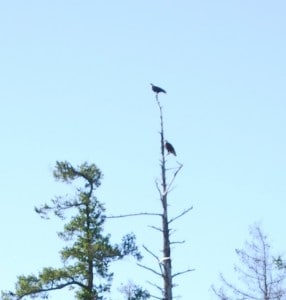
As I was working on dinner one evening – and Kap was in the cockpit straightening things up in the lazarette as she’s wont to do – she called out for me to come outside. An eagle was diving on a family of geese just 100' off our stern, presumably a mom and pop, and three goslings. As it repeatedly dove from about 100’ above the water – obviously aiming for the goslings, but missing each time because the parents were loudly issuing orders to the goslings to dive underwater for safety. I just knew the eagle would come up with a gosling in his talons, but was very relieved it wasn't successful. Soon a second eagle joined in. They might have tired from the strenuous dives and climbs, as they soon headed for a treetop on the shore. They chatted loudly for several minutes, sounding like they were frustrated, either with each other, or with the family of geese now paddling away as fast as they could to safety. (The eagle’s voice is not consistent with the majesty of the bird – it’s high-pitched, almost squeaky, and isn’t melodic at all. It is distinctive, though, which is rather fortunate for us when we have ZuZu on board.)
Finally, after four days of reported high winds on the Strait of Georgia, Kap decided it was time to go – it was Wednesday, June 15th, and Desolation Sound was calling us.
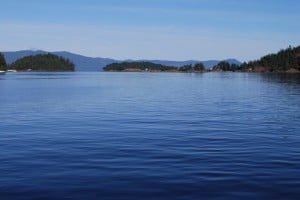
As we neared the entrance to Pender Harbour, the day was so calm, little wind, and skies a bright blue, we knew the odds were in our favor that we’d have a good ride to Desolation Sound.
We were up at 5AM, and with a suggested best time of 7:30 from our Nobeltec chart plotting software, we left the docks at the Seattle Yacht Club Garden Bay Outstation at 7:25AM. Sure enough, it was calm as we pulled into Malaspina Strait – the mile-wide passage between Texada Island and the mainland.
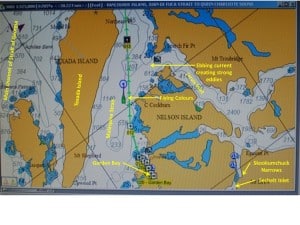
A few miles north of Pender Harbour is Jervis Inlet, a quite large inlet, with one arm leading through Skookumchuck Narrows to Sechelt Inlet, and a lot of water to ebb into Malaspina Strait on the outgoing tide. We were on a spring tide, and the swift flowing current can create a lot of eddies and whirlpools in Malaspina Strait, as well as clusters of logs and other debris that’s lifted off the shorelines.
We were catching an ebbing tide that gave us a 2 knot push, so this was a good excuse to throttle back, save a bit of diesel, and enjoy the free ride that mother nature was giving us. There’s no free lunch, though, and at the entrance to Jervis Inlet we were on the lookout for strong eddies and whirlpools that are created out in Malaspina Strait by the rushing water flowing out of Jervis Inlet. The previous spring high tide would likely have lifted logs and debris off the shorelines too, so we were on the watch for logs in the water.
Skookumchuck Narrows, inside Jervis Inlet, is a very narrow neck that connects Jervis Inlet and Sechelt Inlet. It’s so narrow and constricted that the tidal difference between the two sides is huge and the current clocks through it as high as 16 knots. It’s a kayaker’s paradise, with a standing wave that defies belief. I received a link from an SYC member to a very interesting video shot by some kayakers a couple of years ago, showing what can happen even to larger craft if they aren’t careful in Skookumchuck Narrows. The tug driver is lucky to be alive. Take a look at it at: http://dashpointpirate.typepad.com/the_dash_point_pirate_woo/2009/07/video-of-tugboat-capsizing-at-skookumchuck-narrows.html. Turn your sound on and you’ll hear the kayaker who’s filming it. The jet engine sound you hear a minute or so into the video is the tug’s engines racing when it’s upside down and the props are out of the water.
The Skookumchuck Narrows had also unknowingly given Kap fits for the past several days as she tried to plot our course to Desolation Sound while waiting out the weather in Garden Bay. The Narrows are only a few miles north of us – over land, at least. As Kap plotted our course along Malaspina Strait (and then the Strait of Georgia) between Garden Bay and Desolation Sound, the Nobeltec software kept giving her very screwy course times and best departure times. I could hear lots of blue comments coming out of the pilot house as she wrestled with the problem, and knew I should keep my head low and let her sort out whatever the problem was. Finally, she figured out that good ‘ole Nobeltec was using the closest currents in its calculations, and since Skookumchuck was physically closer to us than the currents out in Malaspina Strait, it was using them in its calculations. Once she figured that out, she could tell Nobeltec to ignore that current and use the next closest one – in Malaspina Strait.
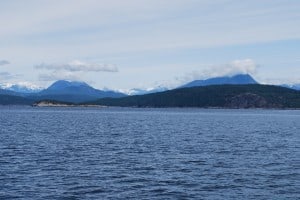
Cruising to Desolation Sound was just as we like it – smooth and easy-going. Ahead on the left is Discovery Channel, with Campbell River on the left, the snow-capped mountains on Vancouver Island, Quadra Island directly ahead, and Desolation Sound to our right.
The five hour cruise to Desolation Sound was without a hitch . . . and smooth – just as we like it. By 1PM we were approaching Cortes Island, with plans to moor for a few days at the Seattle Yacht Club Outstation in Cortes Bay. To our amazement, as we approached I put the binoculars on the dock and saw there wasn’t a single boat there. Either the weather, the economy, or the price of fuel was keeping boaters home this year, at least early in the season. Our bet was they were staying closer to home this year.
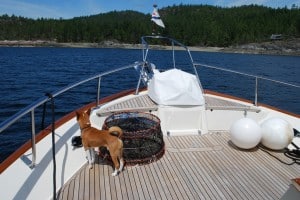
The minute I open the pilot house doors to set up the lines and fenders, Gator wants out on deck and usually heads straight for the bow. He seems to know that the SYC outstation is on the left as we enter Cortes Bay.
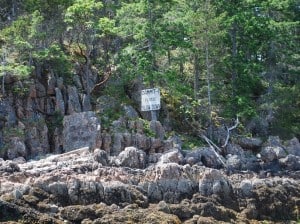
There are a couple dozen waterfront houses scattered around Cortes Bay, and obviously one or more of them don’t like the inconsiderate boaters who race in and out, creating waves that erode the waterfront. This sign is at the entrance to Cortes Bay.
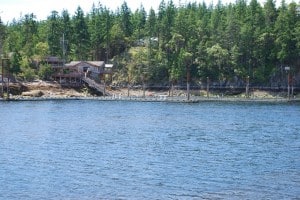
The second outstation in a row – when we arrived there was absolutely no one there, and we’d have the place all to ourselves . . . at least for a short time.
So much of what we do is conditioned on the tides and currents, and this is something newbie boaters to the Northwest really have to pay close attention to. In California, for example, tidal differences are barely a foot, and on the East Coast of the U.S. it can be even less. And obviously, on fresh water lakes, there’s no such thing as tidal effects, so the whole concept is new when going from fresh to salt water boating. (See the nearby two sets of comparison photos to see just how significant high and low tide are at this latitude. We were at a “spring tide”, so the effects are a foot or two more than normal for the rest of the month.)
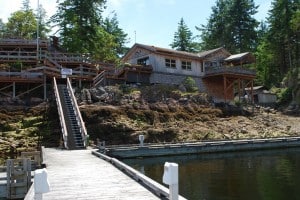
A shot from the floating dock to the SYC clubhouse. It’s a low spring tide, so note how steep the ramp is from shore down to the floating dock. At high tide, the water line is over 15’ higher, and the ramp is almost level. This is why an astute person waits until hightide to haul trash to shore or to bring provisions down to the boat.
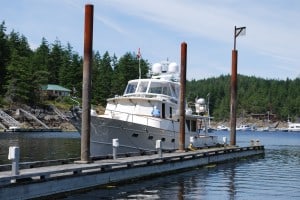
Here are two before/after shots shat show the increasingly low/high tide differences as we continue north (in SE Alaska, the tidal differences are a full 25’). The floating docks are anchored by 16” pipes sunk deep into the bedrock in the bay. At low tide (shown here), the tops of the pipes are higher than Flying Colours. This photo was taken at 1:39PM.
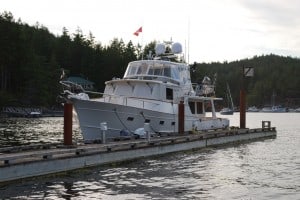
Here’s the same photo, but taken at high tide at 6:56PM, five hours later. The tops of the pipes are only halfway up on Flying Colours.
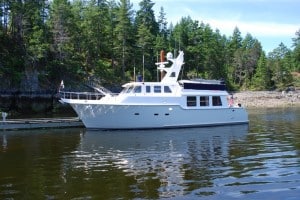
Sure enough, our new friends, Doug and Barb Crim arrived the next day in their Nordhavn 50’, Seaclusion, followed by the new SYC member they’ve just sponsored in her 36’ Grand Banks, the Hattie C. They were also at Garden Bay with us, and Doug has been giving us tips on prawning techniques.
Kap spent the better part of the day working on our prawning equipment and figuring out how we’ll get all that glimp into the dinghy on the way to/from the prawning locations, as well as how to manhandle the gear as we set and retrieve the traps. We’ve reached the conclusion that our current dinghy just doesn’t do the job if we’re going to stay serious about the prawning, and we’re looking at a different make and model that we might get this fall – a Boston Whaler Sport 11 or 13.
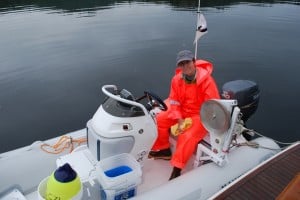
Kap has the dinghy arrangement almost figured out – but it’s going to be cramped with all the prawning glimp aboard. Thanks to Bill Schmidt at Yacht Masters NW for getting our prawn trap puller (an Ace Line Hauler) mounted last winter – without that, we’d probably give up on the idea of pulling two 20+ lb traps up from 350’ water depths. And an even bigger thanks to Kap’s brother and sister-in-law, Elliot and Michele, for giving us a matching pair of “foulies” – actually, they’re rubberized flagman suits, but being lightweight they are perfect for the prawn trips in the dinghy, where you not only get wet, but it keeps us protected from bits of detritus from the incredibly icky prawn bait.
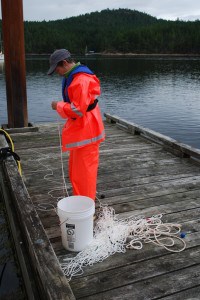
Kap is really good at the fiddly aspects of getting all of the prawning glimp sorted out. Here, she’s sorting out the prawn trap lines, including exactly where to place the lead weights that will ensure extra line isn’t floating on the surface to foul a passing boat’s prop.
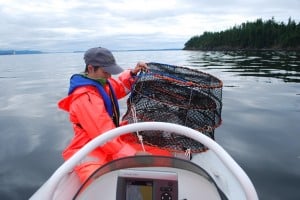
Our 11'-6" dinghy is so cramped for what we're doing that on the way out to the prawning area, Kap has to ride with the prawn traps on her lap.
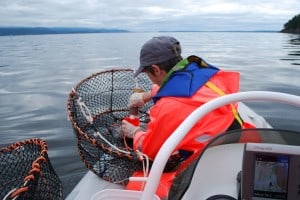
One by one, Kap sets up the bait in the bait holders – the orange plastic cups with lids – then closes them up in the net webbing in the center of the trap and closes up the overall trap netting. The squeeze bottle in her hand is the foul smelling anchovy oil that (presumably) creates the feeding frenzy that attracts the prawns to our trap.
Finally, on Friday morning it’s time to set our prawn traps on our own for the first time. Kap is most familiar with how the lines are all set up, so it’s decided she’ll be in the bow of the dinghy and I’ll drive. Our dinghy is right at the minimum size to handle all this, so she ends up with the prawn traps on her lap as we drive out of Cortes Bay and over to Twin Islands where the local favorite prawning area is.
Prawns tend to live at about 300’ water depth, and all of the pundits tell us they get best results if they set their traps on a seabed slope that’s going down from 300’ to about 350’. There are several such “holes” just off the Twin Islands nearby, so we head for these. We have a Garmin “fish finder” GPS that’s console mounted on our dinghy drive console, and hooked to a sonar transponder. The little 5″ color screen shows underwater depths, and most importantly contour lines of the changing sea floor. As we cruise along, it’s just a matter of watching the depth sounder console and it will lead us directly to the best spot to drop our traps – that is, if we know what we’re doing.
When we get to the area, there are already two orange floats on the surface, marking prawn traps set by a commercial fisherman. Protocol is to drop your traps somewhat away from other traps in the area, first so as to not lay your line (and the traps) over the existing traps, and second, to not diminish the prawns that the nearby trap might otherwise get (there’s enough down there for everyone).
We cruise around until we find just the right spot, and Kap gets to work setting up our traps with bait. This is a messy job, and you really don’t want to get any of it in the boat as it makes a mess and it’s hard to clean up – besides which, it smells to high heaven. You start with “prawn pellets” – some incredibly putrid pellets that look similar to rabbit droppings (which have been soaking in some equally putrid “prawn scent” that we bought at a local outfitter store in Anacortes). Then you add some canned cat food, and finish it off with a squirt of the foulest stuff of all – anchovy oil that we got at place Steve Clark (of Couverden) knows about in Victoria.
All of this “stuff” goes into a bait can that’s sealed with a lid and has small slits in the side to let the dissolved food escape into the current – and hopefully attract the little prawn guys. They pick up the scent and scramble over to the trap, where they cleverly find little openings – net gateways into the trap that are about 3” in diameter – then crawl through to get at the food, only to find that they’re now trapped in our trap. It must be incredibly frustrating for these little guys, being so close to the food but can’t get to it – and worse, they now can’t get out because they don’t understand the little one-way openings – but it’s the only practical way to catch them.
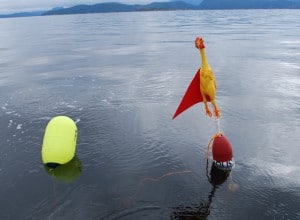
Kap’s rubber chicken keeps watch over our prawn trap. The origin for this idea came from a prawn trap buoy that we’d see year after year on the channel into Ganges in the B.C. Gulf Islands. From a distance it always looked like a rubber chicken floating on the water, and only when we got close to it did we see that it actually wasn’t, but rather, just a float with some “stuff” on it.
Then, it’s over the side for our prawn traps. We’re using two traps on a single line to the surface. The traps are tied together by a 50’ polypropylene line, and they presumably settle to the sea floor that distance apart – the theory being that we increase our prawn catch.
It’s not legal in U.S. waters to “gang” traps together like this, but in Canadian waters, under a recreational fishing license, up to four traps may be fished on a single ground line – and the regulation allows up to four traps per fisherman. Commercial fisherman have totally different regulations, and they often fish a multitude of traps on a single ground line. (If you’re interested in this, complete regulations can be found at: http://www.pac.dfo-mpo.gc.ca/fm-gp/rec/law-loi/gear-equipement-eng.htm.
The last thing to go overboard is the surface float that brings your trap’s ground line to the surface. These can be a navigational hazard that you constantly have to watch out for, and fisheries regulations spell out what’s required. We chose a fluorescent yellow surface buoy, with a second buoy attached to it that Kap (with her crazy sense of humor) mounted a rubber chicken on from Archie McFee’s in Seattle.
After setting the traps, it’s back to Flying Colours, and we let our traps “soak” for two, four, six hours, or maybe even overnight. When it’s time to retrieve them, we head back out. The surface float is retrieved, unhooked from the line, and the line to the bottom is run through the pulleys on the electric hauler sitting right next to me at the dinghy drive console.
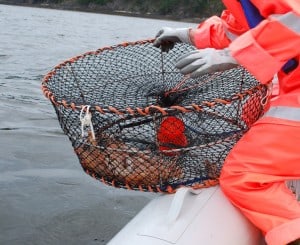
A trap is hauled in and we get our first look at the catch – this time it’s about 20 prawns that you can see in the bottom left of the trap.
Pulling hand-over-hand on the line with just a couple of pounds of pull, the puller brings the line in with incredible ease compared to hauling it up by hand. The line is “flaked” – basically, just dropped – into a 5 gallon bucket as it comes in, and it’s ready to be let out when the traps go back down, without any tangling of the line.
When the first trap is on the surface, Kap hauls it aboard and we get our first glimpse of what we’ve caught – it looks like about 20 prawns in this trap. The trap netting is opened up, and the first order of business is to remove the bait can, and get it safely in another 5 gallon bucket where it can’t make a mess. Then, with gloves on, the shrimp are taken out by hand and dropped into a third bucket filled with salt water.
Then, with the first trap tied off on a cleat at the dinghy bow, the second trap is hauled in and the process of removing the bait can and removing the shrimp repeats. (Oh, I forgot to mention – a tradition that we picked up from Steve and Shirley – on the way out, a wager is made between us on how many prawns we’ll get. The closest to the correct number is paid a loony – a Canadian dollar.)
On our first trap retrieval, we had a total of 32 prawns – not a large catch, but certainly better than our previous best from last year – when we got one measly prawn (using the wrong prawn traps was our conclusion).
Then the hard part begins – snapping the heads off the poor little guys . . . an indispensable aspect of being a carnivore when you’re hunting and gathering your own food. The task falls to Kap, as she’s in the only position to do it (don’t worry, I get my own duty later). We learned how to do this last fall when prawning with Steve and Shirley – you hold the body in one hand, grasp the head with the other, and with one quick twist you snap the head off at the joint with the body. It took me a while to get up the nerve to do it the first time, but it gets easier . . . particularly if you tell yourself each time that it’s worth it when you get to eat it. I’m loathe to kill anything, so I’m a real hypocrite when it comes to being a carnivore.
Some of the prawns we got were outstanding – about ½ again the size we were getting with Steve and Shirley last year in Desolation Sound.
Back on Flying Colours, my task is to fully rinse the prawns in fresh water, then cool them down as quickly as I can by putting them into plastic containers (we reuse soup containers that we’ve brought our favorite soups in from Metropolitan Market in Seattle). About 20 prawns fit in a container, and it goes into the fridge – drained of water as much as possible.
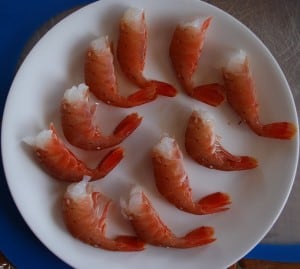
This photo shows a batch of prawns still in the shell. Note the color - they're the color that most people think of with already cooked prawns, but these are spotted prawns, and they're pink when they're raw, and turn more of a white when cooked. These guys are pretty good sized, and are definitely in the BBQ size category.
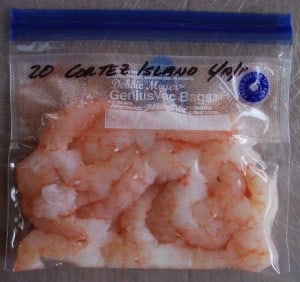
After shelling, they’re rinsed again – some people really like the pink syrupy goo that prawns give off, but not me, and I give them one last rinse – and then into a Ziploc bag that I can vacuum seal for the freezer. These are marked as 20 prawns from Cortes Island, and the date is 6/17/11.
The next day, my task is to sit down at the salon table, with the teak wrapped in Saran Wrap so that the fresh prawn juice won’t stain the wood. Then, one by one I shell the prawns, including the tail. The hard part is unwrapping those first 2-3 shell layers – holding the prawn in the palm of one hand, you have to gently get the thumb of the other hand under first shell layer by catching it with the fingernail. You then work the back of the thumbnail around the prawn, peeling the shell layer away as you twist the prawn with the other hand. This all has to be done gently, otherwise the fragile prawn body can get mangled. At least 2-3 shell layers have to be unwrapped. The easy part is next, when the prawn body is halfway unwrapped – you then squeeze the tail between two fingers and it “squirts” the body out of its shell, and the intestinal track is pulled out with it. You don’t have to slit them down the back to remove this bit that isn’t too good to eat, as you do with store-bought prawns.
Then, after one last rinse in fresh water, a meal’s worth (for two) of prawns are bagged into a Reynold’s Handi-Vac bag. (These neat gizmos seem to have disappeared from the store shelves. You could find two different brands and models in any supermarket, or at Fred Meyers or Target, five years ago, but for some reason they’ve disappeared. I managed to track down three or four of them (to have spares on hand), and I’ve recently found the bags available on E-bay under the Debbie Meyer label (the green bag lady). The bags are quite expensive, but the vacuum sealing is very easy, and the little vacuum hand-gadget is slick as a whistle.)
The prawns are only one layer thick in the bag, and when frozen they stack nice and compact in the freezer. Each bag is labeled with the prawn count, where we got them, and the date – this is essential if you ever get boarded by a fisheries boat to ensure you have a legal limit on board.
The daily catch limit in B.C. is 200 prawns per fishing license (so since Kap and I both have a B.C. fishing license, we can bring up 400 total on any given day), and our total in-possession limit at any one time is 400 per license (or 800 total). That’s a lot of shrimp, but it’s what we hope to have on hand by end of the summer. (By the way, our annual B.C. fishing license costs C$115 each, so the cost per prawn for sport fishing is pretty pricy.)
Earlier in the day (same day I took the sunset photo), I took Gator for a walk. It was intended to be just up the nearby road a ways to give his (and my) legs a bit of exercise. We ended up walking to the other side of Garden Bay to a tiny settlement that contains the Royal Vancouver Yacht Club Outstation, a couple of restaurants, a small marina, a very small general store, and a ramshackle hotel. It was a good two-hour walk, and I think I tired poor Gator out.
I think it’s safe to say that Kap and I have truly graduated to “hunter/gatherers” – at least for the shellfish that we eat.

